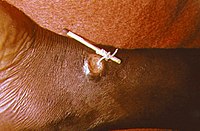
Photo from wikipedia
Global eradication of human Guinea worm disease (dracunculiasis) has been set back by the emergence of infections in animals, particularly domestic dogs Canis familiaris. The ecology and epidemiology of this… Click to show full abstract
Global eradication of human Guinea worm disease (dracunculiasis) has been set back by the emergence of infections in animals, particularly domestic dogs Canis familiaris. The ecology and epidemiology of this reservoir is unknown. We tracked dogs using GPS, inferred diets using stable isotope analysis and analysed correlates of infection in Chad, where numbers of Guinea worm infections are greatest. Dogs had small ranges that varied markedly among villages. Diets consisted largely of human staples and human faeces. A minority of ponds, mostly <200 m from dog-owning households, accounted for most dog exposure to potentially unsafe water. The risk of a dog having had Guinea worm was reduced in dogs living in households providing water for animals but increased with increasing fish consumption by dogs. Provision of safe water might reduce dog exposure to unsafe water, while prioritisation of proactive temephos (Abate) application to the small number of ponds to which dogs have most access is recommended. Fish might have an additional role as transport hosts for Guinea worm, by concentrating copepods infected with worm larvae.
Journal Title: PLoS Neglected Tropical Diseases
Year Published: 2020
Link to full text (if available)
Share on Social Media: Sign Up to like & get
recommendations!